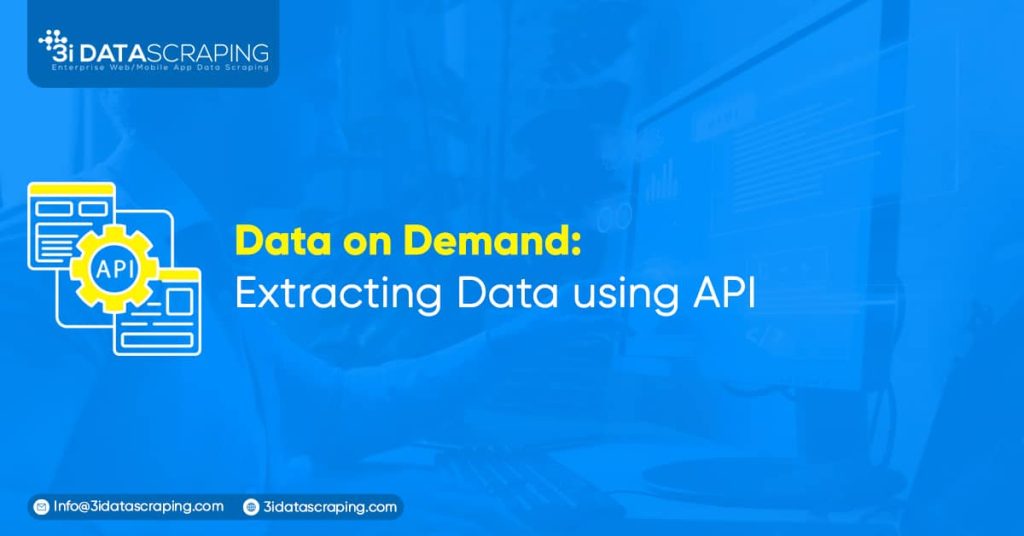Data on Demand: Extracting Data using API
Learn about Data on demand, ways to scrape the same using an API, the benefits, and more.
- March 31, 2023
Our achievements in the field of business digital transformation.









API An Introduction
Information has always been a crucial part of any enterprise. Using the same can lead to a boost in one’s popularity and success. Today companies have the option to scrape Data API, which plays an essential role in scraping the needed data on demand without much ado.
But what exactly do we mean by Data on demand? What does an API stand for, and why is it beneficial for businesses?
Well, let us dive deeper to know more about it:
Data on demand is an option by which users can ask for real-time data viewing by starting a user event once. These are, in other words, those data that become available the moment they get created.
API refers to an Application Programming Interface. These are instructions related to programming and standards to access web-based software applications. The API that scrapes enable a programmer to gain insights into specific content from any website and extract it into their script or application.
In API methods, Endpoints work in conjunction. Endpoints are those specific URLs an application uses to converse with third-party users and services.
Thus, API scraping is a method of data collection in which requests are made to endpoints found when analyzing the traffic between the web server and the site.
With the help of an API, one can scrape information in various ways. The most popular method is to use an HTTP GET request to gain access to specific content from a web server. The content that gets back can become available in HTML, JSON, XML format, or a different format with the web servers’ support.
Yet another way to extract information using an API is to select a web scrapings tool like BeautifulSoup or Scrapy. These options aid a programmer in writing any script that will scrape the relevant data automatically from a website.
Web Scraping APIs use advanced techniques such as JavaScript rendering, proxy rotation, CAPTCHA avoidance, and blocking to scrape information from websites. These techniques and methods help ensure the data is accurately collected and efficiently used while avoiding getting blocked by anti-scraping parameters.
Businesses can use some web extraction tools to gain access to APIs. However, some websites do not contain API, and one can access them using web scraping software. In situations like these, programmers must extract the information manually.
APIs help applications, systems, and devices interact by sharing data. Most APIs are found between the application and the web server. They initiate a call linked to APIs that tell the application to do a task, where the application uses the same API to ask the webserver to carry out a task.
In other words, the API works as a bridge between the web server and the chosen application. Therefore, each time software gets used to communicate with online servers or different software, APIs get used to requesting to get the required information.
While web APIs are essential, they are not limited to the web. On the contrary, every system has an API that helps interact with other systems.
Above all these, no matter what method gets used to scrape data, it is ideal to know the terms and services of the concerned website. Scraping information without the consent of the website owner can get one in trouble and would get deemed a violation of the terms of services.
But with its popularity comes different myths that are untrue to a great extent and that should get debunked.
Well, let us burst into some of the most popular misconceptions and clear the doubts that sit in the minds of people while using data extraction methods for their businesses:
Benefits of Scraping Data using API Tools

Benefits of Scraping Data using API Tools:
1. Time-Saver
A scraping API automates the extraction process compared to manual search, which is time-consuming, often faulty, and cumbersome. These APIs save time by narrowing down numerous requests to one.
2. Structured data
The unorganized data collected through regular web extraction must be processed to gain better insights. On the contrary, APIs work and filter out information that is irrelevant and offer necessary data in a structured format that is easy to understand.
3. Controls Website Traffic
Scraping through API has yet another benefit. These tools do not encourage independent extraction. With APIs, users need not send numerous requests and put the data together independently. These also reduce the burden of websites dealing with crashes that occur because of the high influx of traffic.
4. Speed
APIs have an in-built mechanism that helps them in faster data extraction. The web scraping API’s complex features help gather a large volume of information with minimum action, aiding companies in completing their work better and more efficiently.
5. Better Integration
One of the most intriguing characteristics of a web scraping API is that it can get implemented into any developer application. Adding specific credentials and a sound knowledge of API documentation can help go with the flow.
6. Customization
After fulfilling the first request, companies can focus entirely on the data that concerns them, which is yet, another great advantage of web scraping APIs, i.e., their customization feature. From helping in API calls and geotargeting to having custom scrapers and dedicated accounts, a web scraping API enables the user to have a personalized effect and use the given features to their maximum potential to fulfill all the scraping goals of the business.
Ways to Scrape Data using API

To Scrape Data using API, follow the mentioned method:
- Begin by installing libraries and importing the same.
- Load the data scraped before. Now, focus and select the data that you want to scrape.
- Get suggestions to know the exact data name and inspect the same.
- Scrape the most probable data required.
- If any of the data seems ambiguous, change it manually.
- The next step is to retrieve the info boxes and inspect the attributes.
- These info boxes contain the required data.
Define the features that get required from the info boxes. - Now fetch the data.
- You have successfully retrieved the needed info box data per your requirements.
- Export the scraped info boxes as a single JSON file to a convenient location per the need.
With this, scraper API has done its part, and the data has been collected to be used by companies and enterprises for their benefit.
Final Thoughts
Today, the world is filled with different information available on the internet. These are valuable assets for any organization, business, developer, or marketer to run and boost their business. The data help make better decisions, develop new products, or correct prior decisions.
As such, scraping the same becomes necessary. In this, web scraping and scraping APIs have made their mark by helping companies extract data in real time and using the same to improve their overall output.
Indeed, web scraping combined with scraper API has revolutionized the data collection process and is likely to add more in the times to come, helping companies in their future endeavors.














What Will We Do Next?
- Our representative will contact you within 24 hours.
- We will collect all the necessary requirements from you.
- The team of analysts and developers will prepare estimation.
- We keep confidentiality with all our clients by signing NDA.





